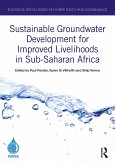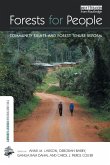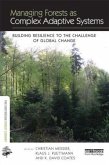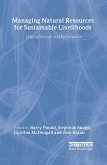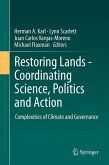Restoring Forests and Improving Livelihoods in Nepal
Four Decades of Community Forestry
Herausgeber: Ojha, Hemant; Paudel, Naya S.; Shrestha, Krishna K.
Restoring Forests and Improving Livelihoods in Nepal
Four Decades of Community Forestry
Herausgeber: Ojha, Hemant; Paudel, Naya S.; Shrestha, Krishna K.
- Gebundenes Buch
- Merkliste
- Auf die Merkliste
- Bewerten Bewerten
- Teilen
- Produkt teilen
- Produkterinnerung
- Produkterinnerung
This book presents a review of Nepal's four decades of community forestry development, delving into when and how community-based management can lead to forest landscape restoration and equitable livelihoods. It will interest students, scholars and practitioners in forest conservation, community development, and environmental policy.
Andere Kunden interessierten sich auch für
![Sustainable Groundwater Development for Improved Livelihoods in Sub-Saharan Africa Sustainable Groundwater Development for Improved Livelihoods in Sub-Saharan Africa]() Sustainable Groundwater Development for Improved Livelihoods in Sub-Saharan Africa149,99 €
Sustainable Groundwater Development for Improved Livelihoods in Sub-Saharan Africa149,99 €![Forests for People Forests for People]() Forests for People59,99 €
Forests for People59,99 €![Managing Forests as Complex Adaptive Systems Managing Forests as Complex Adaptive Systems]() Managing Forests as Complex Adaptive Systems177,99 €
Managing Forests as Complex Adaptive Systems177,99 €![China's Forests China's Forests]() China's Forests177,99 €
China's Forests177,99 €![Managing Natural Resources for Sustainable Livelihoods Managing Natural Resources for Sustainable Livelihoods]() Ann BraunManaging Natural Resources for Sustainable Livelihoods224,99 €
Ann BraunManaging Natural Resources for Sustainable Livelihoods224,99 €![Restoring Lands - Coordinating Science, Politics and Action Restoring Lands - Coordinating Science, Politics and Action]() Restoring Lands - Coordinating Science, Politics and Action115,99 €
Restoring Lands - Coordinating Science, Politics and Action115,99 €![Handbook of Bioenergy Crops Handbook of Bioenergy Crops]() N. El BassamHandbook of Bioenergy Crops326,99 €
N. El BassamHandbook of Bioenergy Crops326,99 €-
-
-
This book presents a review of Nepal's four decades of community forestry development, delving into when and how community-based management can lead to forest landscape restoration and equitable livelihoods. It will interest students, scholars and practitioners in forest conservation, community development, and environmental policy.
Produktdetails
- Produktdetails
- Verlag: Routledge
- Seitenzahl: 360
- Erscheinungstermin: 30. September 2025
- Englisch
- Abmessung: 240mm x 161mm x 24mm
- Gewicht: 705g
- ISBN-13: 9781032705590
- ISBN-10: 1032705590
- Artikelnr.: 74445723
- Herstellerkennzeichnung
- Libri GmbH
- Europaallee 1
- 36244 Bad Hersfeld
- gpsr@libri.de
- Verlag: Routledge
- Seitenzahl: 360
- Erscheinungstermin: 30. September 2025
- Englisch
- Abmessung: 240mm x 161mm x 24mm
- Gewicht: 705g
- ISBN-13: 9781032705590
- ISBN-10: 1032705590
- Artikelnr.: 74445723
- Herstellerkennzeichnung
- Libri GmbH
- Europaallee 1
- 36244 Bad Hersfeld
- gpsr@libri.de
Hemant Ojha is an Associate Professor at Australian National University and the Principal Advisor of Global Development at the Institute for Study and Development Worldwide (IFSD), Australia. Krishna K. Shrestha is Professor of Global Development at the University of New South Wales, Australia. Naya S Paudel is a Senior Researcher and former Executive Coordinator at ForestAction Nepal. Rahul Karki is an Executive Coordinator at ForestAction Nepal, a Kathmandu based forestry research institution. Dil Khatri is an Executive Director and Senior Researcher at the Southasia Institute of Advanced Studies (SIAS), a Kathmandu based policy research organization. Sony Baral is Associate Professor at Tribhuwan University, Nepal and Executive Director of The Resource Nepal, a non-profit organization dedicated to building a sustainable future for Nepal and its citizens. Mani Ram Banjade is a researcher at ForestAction Nepal. He holds a PhD in environmental governance and development studies from the Australian National University. Ian Nuberg is Senior Lecturer at the University of Adelaide, Australia. He is also the leader of the ten year EnLiFT project researching the improvement of livelihoods through agroforestry and community forestry in Nepal.
Introduction 1. Nepal's community forestry journey: Themes, challenges, and
contributions 2. Looking back, moving forward: The evolution of community
forestry policy and practice in Nepal Theme 1: Resource tenure and
governance 3. The politics of policy evolution: community forestry
governance and regulatory shifts in Nepal 4. Contested tenure: Legal
rights, administrative barriers, and the everyday negotiations for
community forest access 5. Cross-scale governance: technocracy and local
resistance in community forestry in Nepal Theme 2: Community dynamics,
local institutions, and planning 6. Crumbling commons? The transformation
of forest-dependent societies in changing contexts 7. Institutions at
crossroads: The evolution of collective action in community forestry 8.
Unveiling the elite nexus: The political economy of progress and stagnation
in Nepal's community forestry 9. Reframing community forestry: Critiquing
planning practices and charting a path for revitalisation in Nepal Theme 3:
Forest ecology and management 10. Community forestry ecologies: Forest
dynamics, biodiversity, and emerging challenges 11. Rethinking forest
management: Silviculture, technology, and the future of community forestry
12. Restoring forest ecosystems? Impact of community forestry on
biodiversity, restoration, and ecosystem services 13. Forest-farm
interface: Integrating private and community forestry for landscape-level
management Theme 4: Climate change 14. Restoring systems thinking: Climate
risks, autonomous adaptation, and enabling policy in community forestry 15.
The carbon promise: climate change mitigation potential of
community-managed forestry in Nepal Theme 5: Livelihoods, gender, and
equity 16. Beyond natural capital: Leveraging community forestry for
livelihoods and local economies 17. Beyond tokenism: Women's leadership and
the struggle for inclusive participation in community forestry 18. The
business potential of community forestry: Regulatory barriers, market
uncertainty, and community struggles Conclusion 19. Reimagining forest
communities: key insights from Nepal's community forestry
contributions 2. Looking back, moving forward: The evolution of community
forestry policy and practice in Nepal Theme 1: Resource tenure and
governance 3. The politics of policy evolution: community forestry
governance and regulatory shifts in Nepal 4. Contested tenure: Legal
rights, administrative barriers, and the everyday negotiations for
community forest access 5. Cross-scale governance: technocracy and local
resistance in community forestry in Nepal Theme 2: Community dynamics,
local institutions, and planning 6. Crumbling commons? The transformation
of forest-dependent societies in changing contexts 7. Institutions at
crossroads: The evolution of collective action in community forestry 8.
Unveiling the elite nexus: The political economy of progress and stagnation
in Nepal's community forestry 9. Reframing community forestry: Critiquing
planning practices and charting a path for revitalisation in Nepal Theme 3:
Forest ecology and management 10. Community forestry ecologies: Forest
dynamics, biodiversity, and emerging challenges 11. Rethinking forest
management: Silviculture, technology, and the future of community forestry
12. Restoring forest ecosystems? Impact of community forestry on
biodiversity, restoration, and ecosystem services 13. Forest-farm
interface: Integrating private and community forestry for landscape-level
management Theme 4: Climate change 14. Restoring systems thinking: Climate
risks, autonomous adaptation, and enabling policy in community forestry 15.
The carbon promise: climate change mitigation potential of
community-managed forestry in Nepal Theme 5: Livelihoods, gender, and
equity 16. Beyond natural capital: Leveraging community forestry for
livelihoods and local economies 17. Beyond tokenism: Women's leadership and
the struggle for inclusive participation in community forestry 18. The
business potential of community forestry: Regulatory barriers, market
uncertainty, and community struggles Conclusion 19. Reimagining forest
communities: key insights from Nepal's community forestry
Introduction 1. Nepal's community forestry journey: Themes, challenges, and
contributions 2. Looking back, moving forward: The evolution of community
forestry policy and practice in Nepal Theme 1: Resource tenure and
governance 3. The politics of policy evolution: community forestry
governance and regulatory shifts in Nepal 4. Contested tenure: Legal
rights, administrative barriers, and the everyday negotiations for
community forest access 5. Cross-scale governance: technocracy and local
resistance in community forestry in Nepal Theme 2: Community dynamics,
local institutions, and planning 6. Crumbling commons? The transformation
of forest-dependent societies in changing contexts 7. Institutions at
crossroads: The evolution of collective action in community forestry 8.
Unveiling the elite nexus: The political economy of progress and stagnation
in Nepal's community forestry 9. Reframing community forestry: Critiquing
planning practices and charting a path for revitalisation in Nepal Theme 3:
Forest ecology and management 10. Community forestry ecologies: Forest
dynamics, biodiversity, and emerging challenges 11. Rethinking forest
management: Silviculture, technology, and the future of community forestry
12. Restoring forest ecosystems? Impact of community forestry on
biodiversity, restoration, and ecosystem services 13. Forest-farm
interface: Integrating private and community forestry for landscape-level
management Theme 4: Climate change 14. Restoring systems thinking: Climate
risks, autonomous adaptation, and enabling policy in community forestry 15.
The carbon promise: climate change mitigation potential of
community-managed forestry in Nepal Theme 5: Livelihoods, gender, and
equity 16. Beyond natural capital: Leveraging community forestry for
livelihoods and local economies 17. Beyond tokenism: Women's leadership and
the struggle for inclusive participation in community forestry 18. The
business potential of community forestry: Regulatory barriers, market
uncertainty, and community struggles Conclusion 19. Reimagining forest
communities: key insights from Nepal's community forestry
contributions 2. Looking back, moving forward: The evolution of community
forestry policy and practice in Nepal Theme 1: Resource tenure and
governance 3. The politics of policy evolution: community forestry
governance and regulatory shifts in Nepal 4. Contested tenure: Legal
rights, administrative barriers, and the everyday negotiations for
community forest access 5. Cross-scale governance: technocracy and local
resistance in community forestry in Nepal Theme 2: Community dynamics,
local institutions, and planning 6. Crumbling commons? The transformation
of forest-dependent societies in changing contexts 7. Institutions at
crossroads: The evolution of collective action in community forestry 8.
Unveiling the elite nexus: The political economy of progress and stagnation
in Nepal's community forestry 9. Reframing community forestry: Critiquing
planning practices and charting a path for revitalisation in Nepal Theme 3:
Forest ecology and management 10. Community forestry ecologies: Forest
dynamics, biodiversity, and emerging challenges 11. Rethinking forest
management: Silviculture, technology, and the future of community forestry
12. Restoring forest ecosystems? Impact of community forestry on
biodiversity, restoration, and ecosystem services 13. Forest-farm
interface: Integrating private and community forestry for landscape-level
management Theme 4: Climate change 14. Restoring systems thinking: Climate
risks, autonomous adaptation, and enabling policy in community forestry 15.
The carbon promise: climate change mitigation potential of
community-managed forestry in Nepal Theme 5: Livelihoods, gender, and
equity 16. Beyond natural capital: Leveraging community forestry for
livelihoods and local economies 17. Beyond tokenism: Women's leadership and
the struggle for inclusive participation in community forestry 18. The
business potential of community forestry: Regulatory barriers, market
uncertainty, and community struggles Conclusion 19. Reimagining forest
communities: key insights from Nepal's community forestry


